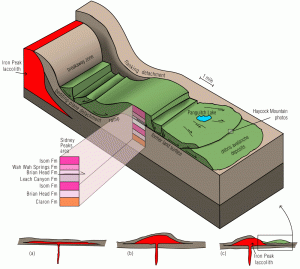Vertically exaggerated block diagram of an idealized gravity slide. Here, the trigger is a shallow igneous intrusion (the Iron Peak laccolith) emplaced within a few hundred feet of the Earth’s surface, causing arching of overlying strata and consequent failure on over-steepened slopes. Note the four main bounding surfaces: the bedding-plane detachment in mechanically weak clay-rich rocks of the Brian Head Formation; the ramp, where the slide mass breaks upward to the surface; the former land surface, now covered by the slide mass; and the flanking detachment, in essence a strike-slip fault that bounds the margin of the slide. The basal detachment resembles shallow low-angle faults, complete with slickensided and striated surfaces, gouge zones, and brittle microfabrics. Extensional deformation characterizes the upper part of the slide, whereas compressional deformation characterizes the toe area. The main part of the gravity slide remains mostly intact with individual blocks as much as several square miles in size, preserving a stratigraphy inherited from the source area. Frontal portions of the slide mass disaggregate into debris avalanche deposits. Because gravity is the ultimate driver of such large landslides, the dip of the slip surface must be sufficient to overcome the shear or frictional strength of the detachment layer (but still is likely less than a few degrees). Once moving, however, the slides can travel many miles over former land surfaces.
Inset shows growth of laccolith: (a) initial lateral injection of igneous intrusion to its fullest extent, (b) vertical growth of laccolith from continued injection of magma, and (c) gravity sliding of oversteepened flanks. Modified from Hacker and others (2002).




Leave a Reply
Want to join the discussion?Feel free to contribute!